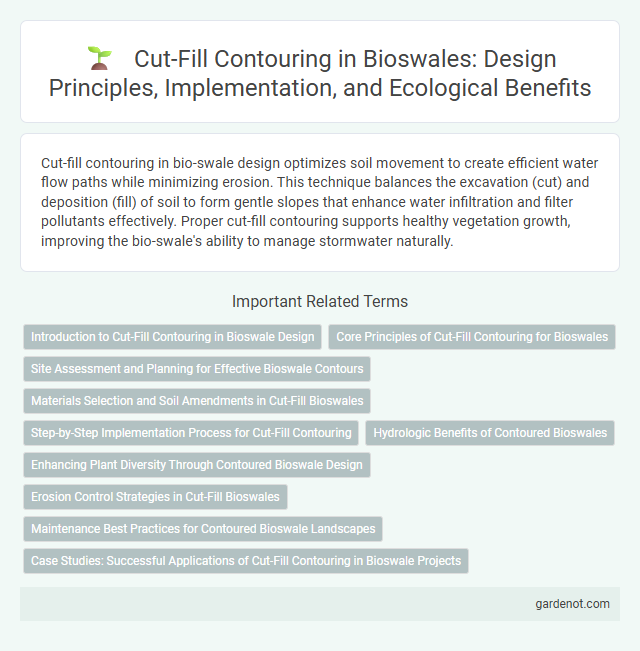Cut-fill contouring in bio-swale design optimizes soil movement to create efficient water flow paths while minimizing erosion. This technique balances the excavation (cut) and deposition (fill) of soil to form gentle slopes that enhance water infiltration and filter pollutants effectively. Proper cut-fill contouring supports healthy vegetation growth, improving the bio-swale's ability to manage stormwater naturally.
Introduction to Cut-Fill Contouring in Bioswale Design
Cut-fill contouring in bioswale design involves strategically reshaping the land by cutting soil from elevated areas and filling lower sections to create defined channels for stormwater runoff. This technique optimizes water infiltration, reduces erosion, and enhances pollutant filtration within the bioswale system. Proper cut-fill balance ensures efficient drainage while promoting vegetation growth and maximizing the bioswale's ecological benefits.
Core Principles of Cut-Fill Contouring for Bioswales
Cut-fill contouring for bioswales involves strategically excavating and redistributing soil to create gentle slopes that efficiently channel stormwater runoff into vegetated swales, enhancing infiltration and reducing erosion. The core principles emphasize maintaining balance between cut and fill volumes to prevent excess soil displacement, preserving natural landform stability while optimizing water flow paths. Proper contour design integrates soil permeability and vegetation compatibility to maximize pollutant filtration and groundwater recharge within the bioswale system.
Site Assessment and Planning for Effective Bioswale Contours
Site assessment for effective bioswale cut-fill contouring involves analyzing soil composition, topography, and hydrology to ensure optimal water capture and filtration. Precise cut and fill techniques shape contours that direct stormwater flow efficiently, reducing erosion and promoting groundwater recharge. Incorporating site-specific elevation data and vegetation patterns enhances bioswale functionality and sustainability.
Materials Selection and Soil Amendments in Cut-Fill Bioswales
Cut-fill contouring in bioswales requires selecting materials with high permeability and structural stability, such as sandy loam soils blended with organic compost, to enhance water infiltration and filtration. Soil amendments like biochar and mycorrhizal fungi improve soil aeration and nutrient cycling, promoting plant growth and microbial activity essential for pollutant breakdown. Properly engineered fill materials combined with tailored soil amendments optimize hydrological functions and increase the bioswale's effectiveness in managing stormwater runoff.
Step-by-Step Implementation Process for Cut-Fill Contouring
Cut-fill contouring for bio-swales involves systematically excavating soil from high points (cut) and placing it in low areas (fill) to create optimal drainage and infiltration patterns. The process begins with detailed topographic surveying to identify elevation differences, followed by calculating cut and fill volumes using contour mapping software. Precise grading is executed with machinery to form contours that efficiently direct stormwater through vegetation while minimizing erosion and promoting groundwater recharge.
Hydrologic Benefits of Contoured Bioswales
Cut-fill contouring in bioswales enhances hydrologic benefits by optimizing water infiltration and reducing surface runoff. This technique shapes the land to follow natural water flow, promoting groundwater recharge and minimizing erosion. Contoured bioswales effectively manage stormwater, improving water quality through sediment capture and pollutant filtration.
Enhancing Plant Diversity Through Contoured Bioswale Design
Cut-fill contouring in bioswale design strategically reshapes the land to create microhabitats by varying moisture levels and soil depths, promoting diverse plant communities. This technique improves water retention and nutrient distribution, supporting native vegetation and enhancing biodiversity within the bioswale system. By optimizing terrain contours, cut-fill methods facilitate species-rich habitats that contribute to ecological resilience and effective stormwater management.
Erosion Control Strategies in Cut-Fill Bioswales
Cut-fill contouring in bioswales enhances erosion control by shaping the land to manage water flow and reduce soil displacement. Strategic excavation and grading techniques create stable slopes that limit runoff velocity, promoting infiltration and sediment retention. Integrating native vegetation further stabilizes soil, minimizes erosion, and supports ecological resilience in cut-fill bioswale designs.
Maintenance Best Practices for Contoured Bioswale Landscapes
Cut-fill contouring in bioswale landscapes ensures optimal water flow and erosion control by strategically reshaping soil elevations. Regular maintenance best practices include monitoring sediment accumulation, managing vegetation to prevent overgrowth, and inspecting contours for signs of erosion or deposition. Effective upkeep enhances stormwater filtration, prolongs bioswale functionality, and supports sustainable urban drainage systems.
Case Studies: Successful Applications of Cut-Fill Contouring in Bioswale Projects
Case studies on cut-fill contouring in bioswale projects demonstrate significant improvements in stormwater management and erosion control by precisely shaping the land to optimize water flow and infiltration. Projects in urban and suburban areas show that strategic cut-and-fill techniques reduce runoff volume by up to 40%, enhance sediment capture, and support healthier vegetation growth. These applications highlight the effectiveness of contouring in maximizing bioswale performance, reducing infrastructure costs, and promoting sustainable landscape design.
Cut-fill contouring Infographic

 gardenot.com
gardenot.com